Cruise Market
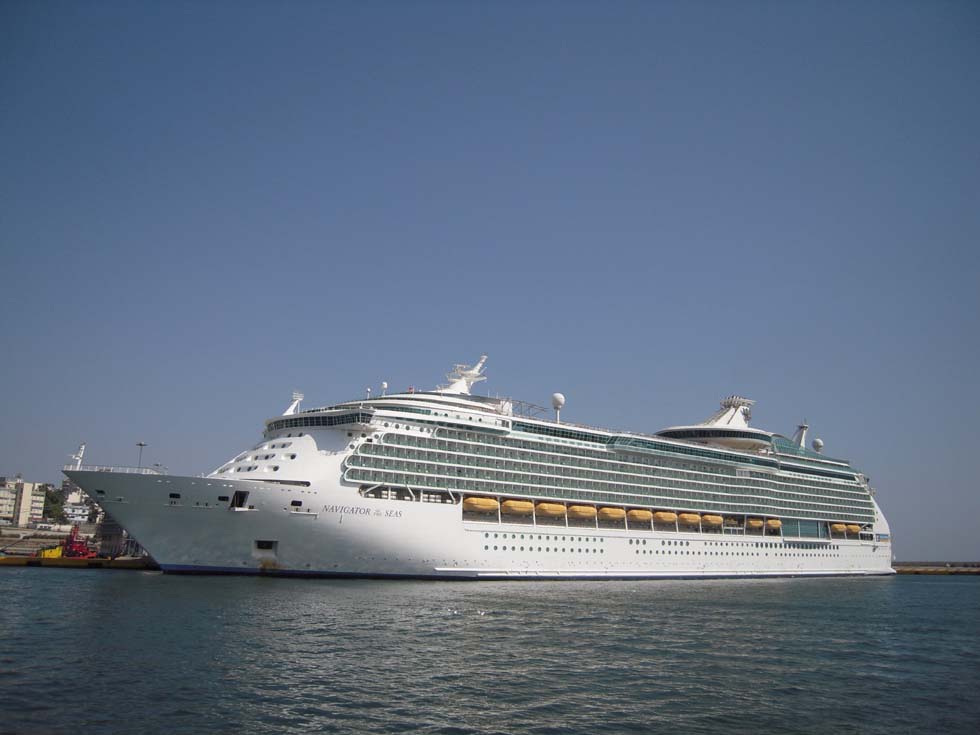
“Navigator of the Seas”, Royal Caribbean, Piraeus 2012 (WS)
The fascination of the ocean giants was reborn when the classic ocean liners of the past had gone. “When I first started working on shipboard the cruise industry was almost dead and about to be buried at sea”, wrote Jeraldine Saunders, author of ‘The Love Boat’ television series, which contributed so much to the final success of cruising, stating (in the book ‘Love Boats’): “The life on board that people viewed on TV was a life they wanted to live, so they did!”
Cruise ships are the only survivors in passenger shipping, apart from the numerous ferries. But contrary to the ferry operations, cruising is confined to people of the rich countries, nevertheless it was growing for decades. In the 70s a number of half a million cruise passengers per annum became estimated, still much less than the 1.07 million passengers alone on the North Atlantic, reported by the Atlantic Conference for its member companies in the record year 1929. By 1980 however, the number of 1.4 million cruise passengers was reported by the Cruise Lines International Association (CLIA) for its member companies. For 2010 the Berlitz Guide stated more than 20 million, mostly American. According to the World Tourism Organization, in 2004 road traffic had a share in tourism of 45%, air transport 43%, shipping 7% and rail 4%. Airlines carried already at the turn of the century 1.6 billion passengers, but of course figures and fares cannot be compared. Contrary to certain subsidized ocean liners and the government-owned airlines of the past, cruising is dependent on the yield got from the clients. A typical 7-day Caribbean cruise costs now half the price compared to the 1980s, if adjusted for inflation. And cruise fares are “all inclusive”, except service compensation, alcohol and land excursions (people can take a taxi, it’s cheaper). In April 2008 however, Lloyd’s List wrote: “Inflation, a weak dollar, and higher shipbuilding costs have convinced Carnival Corp. & PLC to halt any new ship orders for US-based brands beyond those already on the books…” In 2009 Lloyd’s List fortunately enough could inform that successful Carnival achieved “a better return than expected”. And in 2013, Ships Monthly reported Royal Caribbean’s order for a third record-breaking megaship of the Oasis class. Only a truly severe crisis must hit cruise shipping incomparably harder then cargo shipping or truck ferries, the indispensable means of transport.
Passengers
To go on a cruise was an early form of tourism, initially confined to an extremely small, well-situated clientele. Gradually sea voyages just for fun have become affordable also to the middle class of wealthy countries in the Western world. That development started in America with three- and four-day cruises, while many European companies with expensive long cruises failed, possibly influenced also by the lot of prejudice against cruising, in Germany decades ago nourished by some old-style daily press. According to CLIA, the average length of a cruise in the American market was about 7 days in 2005. The average age of passengers was estimated by Frommer’s Cruises & Ports of Call in 2007 e.g. for Cunard “in the 50s and up.” Carnival Cruise Lines however, according to that source, “estimates about 30% of passengers are under age 35, another 40% are between 35 and 55, and 30% of passengers are over age 55.” Around 85% of passengers on Caribbean cruises were estimated American and on Mediterranean cruises European. Worldwide, according to press releases, almost 60% among the cruise passengers in 2005 were American and not even 30% European, in the past warded off by much higher fares. At the turn of the century, Financial Times Deutschland (14 April 2000) had written: “The Germans are still hesitating (…). Too fixed is the imagination of cruises as a matter of rich aged people, who steadily change clothes, eat and stand at the rail with all their jewelry and melancholy”. In the same year, already 6 million Americans went on a cruise voyage, but the share of Europeans is rising.
An attempt to lure more non-Americans aboard a cruise ship is tried with “ethnic cruises”, e.g. P&O for British, AIDA Cruises for Germans, CDF for French or Pullmantur for Spanish-speaking passengers. That means a revival of the past, when Englishmen strictly used British ocean liners, Frenchmen the French and Germans the German ships of national prestige. All these above-mentioned brands however are subsidiaries of world’s big cruise shipping groups. With AIDA and Ocean Village, special brands for a younger clientele were started, totally casual, but they did not revolutionize cruising completely and the end of Ocean Village was decided in 2010. Not so revolutionary, but less formal became Norwegian with ‘Freestyle Cruising’. The companies with cruises for everybody of every country and every age, with activities for youngsters as well as elegant formal nights, continued to have the biggest number of passengers. The brand Carnival Cruise Lines counted in the early years of the 21st century more than 3 million passengers per annum, tightly followed by Royal Caribbean International, ahead of Princess Cruises. For these leaders, operating with reasonable fares, also the highest occupancy rate is estimated.
Considering the economic growth in the Asia-Pacific region, cruise shipping in that region was at the turn of the century surprisingly underdeveloped. Star Cruises started a market for Asia’s emerging middle class. Ships of the great American or European brands on cruises on the Pacific Rim however had almost exclusively American passengers, also Asians with American passport, or Europeans on board. Worldwide in the year 2000 among all the cruise passengers, 82% were American or European and only 18% came from other regions. Let’s hope that in future more people from all over the world can enjoy that wonderful way of travelling.
Destinations
Wealth did spread mainly in the Northern Hemisphere, in countries with rough climate, and so it is quite natural that the mainstream of tourism is flowing from the north to the pleasant south. In 2005 the destinations for almost two thirds of the cruise passengers were the seas of America, generally the Caribbean. During the summer half-year however, the Mediterranean caught up with the Caribbean. In midsummer also Northern Europe and Alaska gained on interest. Melting of the Arctic Sea ice has nourished dreams of opening the North-West Passage, the East Siberian Sea route and even a Central Basin route for cruise ships. Also South American cruises had a revival. And cruises on the Pacific and even in the south of Africa developed.
Round-the-world voyages give a few well-to-do passengers the chance to make up their own holiday between the ports of their choice. At the end of the ‘70s, Cunard’s announced minimum fare for a passage Southampton – New York was c. 400 pound, in 2007 for Southampton – Fort Lauderdale 990 euro, relatively moderate, if adjusted for inflation. It’s clearly more expensive than airlines’ special-fare economy flights, but cheaper than business class. So these passages have come within the reach of an upper middle-class of wealthy countries. As airlines’ task has become affordable mass transportation (some designers saw passengers in future locked into windowless cabins of Flying Wing aircraft and already now some airlines force the passengers to close the window blinds all the day, thus preventing any enjoyment of flying), a sea voyage is more attractive. Until now however, transoceanic passages are representing only a tiny marketing segment of cruise shipping. Could they have a revival in future?
Among the favorite ports of departure, Miami and Port Everglades of Fort Lauderdale in Florida are ahead of Southampton or Venice. Once-famous ports, such as Bremerhaven or Cherbourg, have completely fallen behind, while typical intermediate ports-of-call, such as Nassau, San Juan, Cozumel, Skagway or Piraeus, accommodated on some days half a dozen cruise ships or more. A problem is embarkation and disembarkation when ships get bigger. As people prefer attractive cities such as Miami or Venice as ports of departure, innovative terminal buildings would be necessary, perhaps a new task for architects experienced in designing world’s large airports. In Greece, the intention of building a new cruise terminal for Athens at Faliron was published in 2013. In some small ports, big ships have to drop anchor offshore and take passengers to the pier on tenders. Timetables are fixed in advance for the entire season, but sometimes the routes are changed, in contrast to the ocean liners of the past.
In some countries strong regulations restricted the itinerary of cruises. Most famous is the Jones Act of the USA, described by Lloyd’s List: “The Jones Act requires that all goods transported from one US port to another be carried by vessels built in the US, and owned, crewed and operated by American citizen entities”. U.S. Senator McCain opposed it, pointing out disadvantages for the American economy. And the law proved an absurdity, as no cruise ships are being built in the USA. In Europe, the EU brought about opening the harbours as port of departure for all vessels of EU members and many ports were opened to non-EU members, too. In 2010 also China advanced by allowing foreign cruise ships departing from Shanghai to enter other Chinese ports, and a tourist visa for China is easy to obtain. For cruise passengers having booked a tour with a call in India, it proved complicated to get a visa. And in 2010 Louis Cruises stopped cruising from India after only a month, whereupon expresstravelworld.com commented: “This is the second time that a cruise company has had to withdraw operations in India. It says a lot.” A setback for Italy was reported in 2013, when authorities decided to interdict cruise ships of more than 96,000 gt to cross the Canale della Giudecca for entering Venice port - and the more suitable open sea access was not yet prepared.
Cruise shipping is producing a yield not only for shipping companies and shipyards. Airlines are profiting from carrying the passengers to the port of departure. Some all-inclusive voyages however avoid visiting the port city, and may it be a metropolis such as Shanghai or Dubai. An experience the author has made once is the late ticket issue, no problem for package tourists, but unsuitable for individualists who prefer starting their tours weeks before. On some cruises the number of ports-of-call may be reduced, a disadvantage, too. The passengers spend money in the countries visited – the beautiful places in the world, outside America or Europe often the poorest ones (and some rich-country media criticized it).
Companies
During the first years of the 21st century there were more than hundred cruise companies worldwide, the providers of day cruises not included. Initially it were the famous companies running the transoceanic mail lines, which introduced cruising in order to employ their liners out of season. In the age of the jetliner, they changed completely to cruises or closed down their passenger department. With unemployed ocean liners also small companies have built up cruise shipping, emerging into an international market. As the biggest market share is contributed by the USA, the biggest cruise shipping companies developed there. In 1966, Ted Arison of Miami and Knut Kloster of Norway invented modern-day cruising, starting in Florida. Six years later, Arison founded Carnival Cruise Lines and his son Micky Arison extended it, becoming the biggest cruise shipping group of the world. Acquiring renowned companies and maintaining their brand was the recipe for success of the Carnival Corporation. With acquisition of America-based Holland America Line in 1988, Arison’s group had become the market leader. Costa Crociere, then the biggest European company, was bought in 1997 and famous Cunard Line was taken over in 1998. With acquisition of P&O Cruises together with Princess Cruises and Aida Cruises in 2004, Arison’s market share surpassed the 40%, according to Lloyd’s List rising to more than 50%. Royal Caribbean Cruises Ltd, which started in the United States, too, acquired Celebrity Cruises (ex Chandris of Greece) in 1997, but had not succeeded in getting P&O/ Princess and remained number two, with a market share of more than 20% and with the largest and most sensational ships. Pullmantur was added in 2006. Norwegian Cruise Line, the company built up in the USA by pioneer Knut Kloster, became number three with c.10% market share, from 2000 under full control by the group of Star Cruises, an enterprise started in Malaysia (figures according to Welt and Sonntag, 20 Feb. 2005). In 2007 Apollo Management took over a decisive share in NCL. In late 2014 Ships Monthly described the combined ownership under the label Norwegian Cruise Lines Holdings. The Italian company MSC pushed its way to become one of leading brands. It was founded by Gianluigi Aponte, based on his container shipping company, among Europe’s largest. In the United States, Disney Cruise Lines provoked great expectations for future, but concentrated its activities on its special marketing segment. The big companies obtain their yield almost exclusively on the “mainstream” market. A low-fare concept for cruises was tried by Stelios Haji-Ioannou, founder of low-cost carrier easyJet airways, and also Richard Branson’s Virgin airline group has started thinking about cheap cruises. A special segment, classified as “ultraluxury” by fare level, and all the other companies have a comparatively small market share in cruise shipping.
Fleet
By the first decade of the 21st century, the operating fleet of cruise ships of any size has grown on to more than 400 units. When in the 1960s and 70s ocean liners had given way to jetliners, the ships were refurbished for cruises or they went into a scrap yard of a low-cost country. In the past many liners found their end in Taiwan. Then Alang in India has become the best-known place of that industry. Older ships are given away either to subsidiaries or they are sold. With the end of the ocean liner, construction of ships designed specially for cruises was taken up and from the ‘90s building of passenger ships revived on a large scale. In 2006 the Carnival Corporation operated 81 cruise ships, Royal Caribbean Cruises Ltd 29 and Norwegian Cruise Line 13 ones (according to Hemispheres Magazine, March 2007). The largest vessels were classified by Frommer’s as “megaships”, with a lower-berth capacity of 1,800 or more, generally measuring in at more than 60,000 gt, followed by a category of “midsize ships” of c. 20,000 to 60,000 gt and so-called “small ships” below. With the rising size of ships, the term “mega” must be re-defined.
The largest brands are tending more and more to the exclusive use of megaships. Older ships are given away to subsidiaries or they are sold. With the “Sovereign of the Seas” (73,192gt), introduced in 1988 by Royal Caribbean, cruise ships had reached the size (in gross tonnage, not deadweight) of the largest ocean liners of the past. The first passenger ship ever to exceed the 100,000gt barrier was the “Carnival Destiny” of Carnival Cruise Lines, completed in 1996. It was the first cruise ship of “post-Panamax” size. A dimension of 294 by 32.3m was the maximum for passage through the Panama Canal before completion of the new locks with 427m length and 55 m width. Royal Caribbean opened up a new dimension in 1999 with introduction of the 137,276gt “Voyager of the Seas”. With the “Queen Mary 2”, Cunard Line of the Carnival group introduced in 2004 the most prestigious and with 148,528gt world’s largest passenger ship. The size was surpassed already in 2006 by Royal Caribbean’s “Freedom of the Seas” with a gross tonnage of 154,407 and a lower-berth capacity of 3,634. A price of c. 700 million dollar had been reported. For the “Queen Mary 2”, contrary to typical cruise ships laid out for regular North Atlantic crossings, the press mentioned almost 1 billion dollar (compare it to the $220 million for an Airbus A380 at that time). Larger ships are to operate more economically than smaller ones and, like in the age of the ocean liners, size is a matter of prestige, too. When the “Freedom of the Seas” of Royal Caribbean was introduced in 2006, that company and Aker Yards had already started studying the 220,000gt “Genesis” project, providing a lower-berth capacity of 5,400. Also Carnival examined to surpass the 200,000-tons barrier with the “Pinnacle” project, but Ships Monthly guessed in 2007 that “Carnival does not apparently see itself in a battle with Royal Caribbean or others to own the biggest ship in the world”. In late 2009 Royal Caribbean introduced the 225,282-ton “Oasis of the Seas”, with her Central Park and her sheer size leaving every passenger ship far behind. The size of tankers already built gave reason to assume that the species of cruise ships has not yet reached its technical limit. It’s the market which will make the decision.
For passengers a smooth ride even at rough seas is of great importance. While the old “Queen Mary” (I) was notorious for rolling, modern passenger ships are equipped with stabilizing fins. An early attempt had been the equipment of the “Conte di Savoia” of 1931 with gyroscope stabilizers, but they proved too uneconomic. Generally built for a moderate speed around 20 to 24 knots and equipped with nowadays’ technology, diesel-electric engines (and the funnel) aft instead of midships, an energy-saving bulbous bow, covered lifeboats due to new safety regulations placed no higher than five decks above sea level, a fully glazed bridge house, innovative navigation devices such as GPS/DGPS and “steering by joystick”, modern cruise ships present themselves quite different from their predecessors. The Navigation Control Station of Royal Caribbean’s Voyager class and successors has two pilot chairs surrounded by radar screens and monitors of the Dynamic Positioning System and the Voyage Management System. The Navigation Station and the Chief Engineer’s working place are positioned in the background. The application of aluminum alloy for components of the superstructure enabled to construct ships with more and wider decks and a comparatively low deadweight. The “Queen Elizabeth 2”, built for crossing the rough North Atlantic, had initially a size of 65,863gt and a deadweight of 15,976 tdw, compared to the “Voyager of the Seas”, built mainly for Caribbean waters, with 137,276gt and only 11,132 tdw. High performance gas-turbo-electric drive has been tried, but on account of rising bunker prices Celebrity Cruises added diesel engines, generally more fuel-efficient. With newbuilds, additional gas-turbines were abandoned. An innovative feature is the replacement of conventional propulsion by azymuthing pods. Instead of heavy screwshafts penetrating the rearship, bundles of cables transmit the electric energy from the generators to the pods, equipped with a forward-facing propeller, powered by an internal electric propulsion motor. In most cases two pods are installed, turning through almost 360 degrees. The pods replace conventional screws, rudder blades and stern thrusters. The “Elation” of Carnival, completed in 1998 at Kvaerner Masa Yards, has become the first cruise ship equipped with that technology, developed by ABB under the trademark “Azipod” and then by Rolls-Royce , marked “Mermaid” pods. Lloyd’s List reported in 2008 that RCCL and the Carnival Group sued “over alleged defects” of Mermaid pods and the “Norwegian Epic” was delivered in 2010 with 2 conventional propellers. The 225,000-ton “Oasis of the Seas” is driven by 3 Azipods and the “Quantum of the Seas” by 2 Azipods.
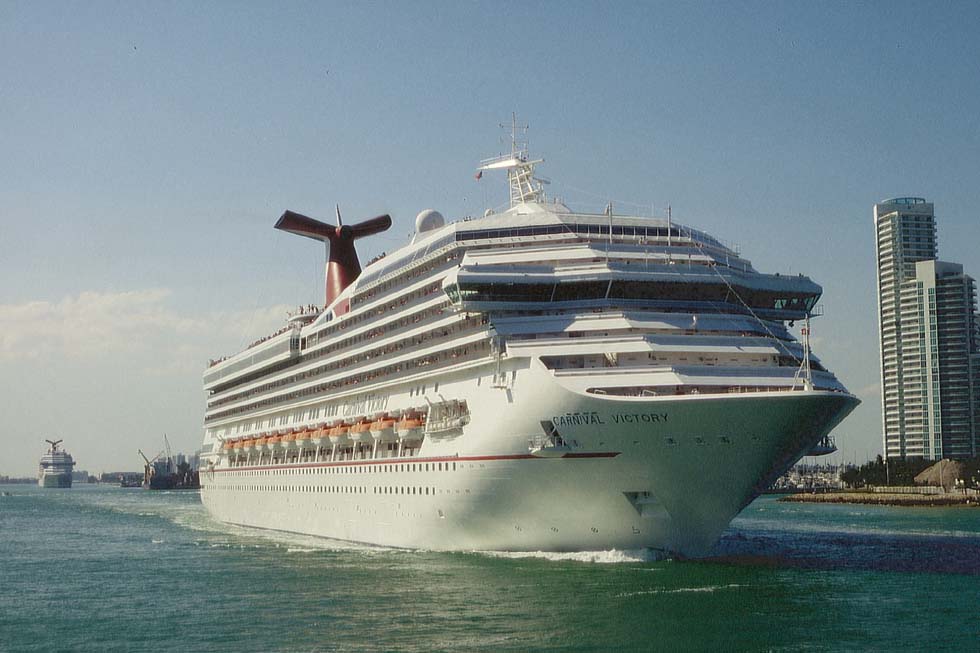
“Carnival Victory” of Carnival’s Destiny class, Miami 2007 (WS)
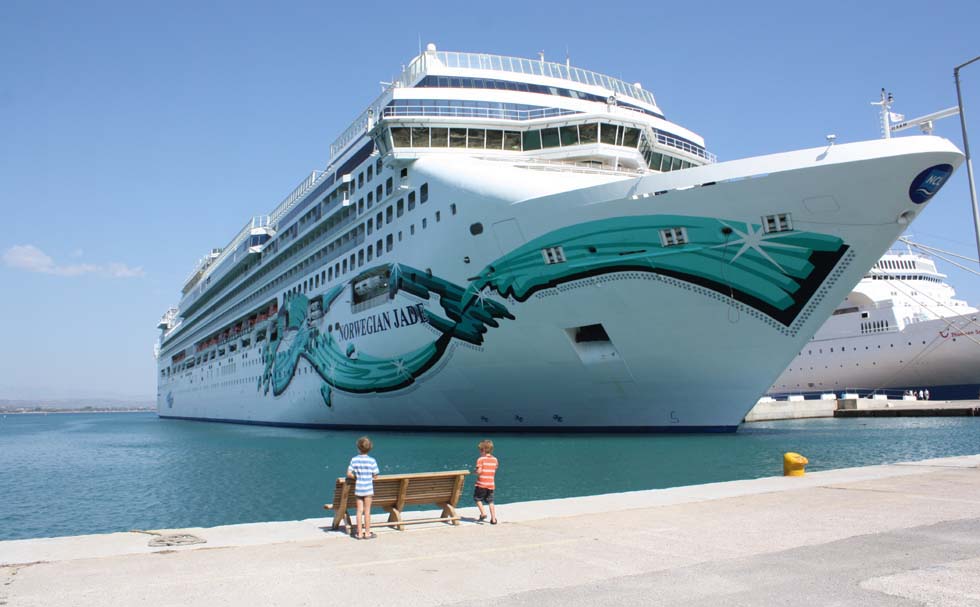
“Norwegian Jade”, ex “Pride of Hawaii”, Katakolon 2011 (Anton Soelch)
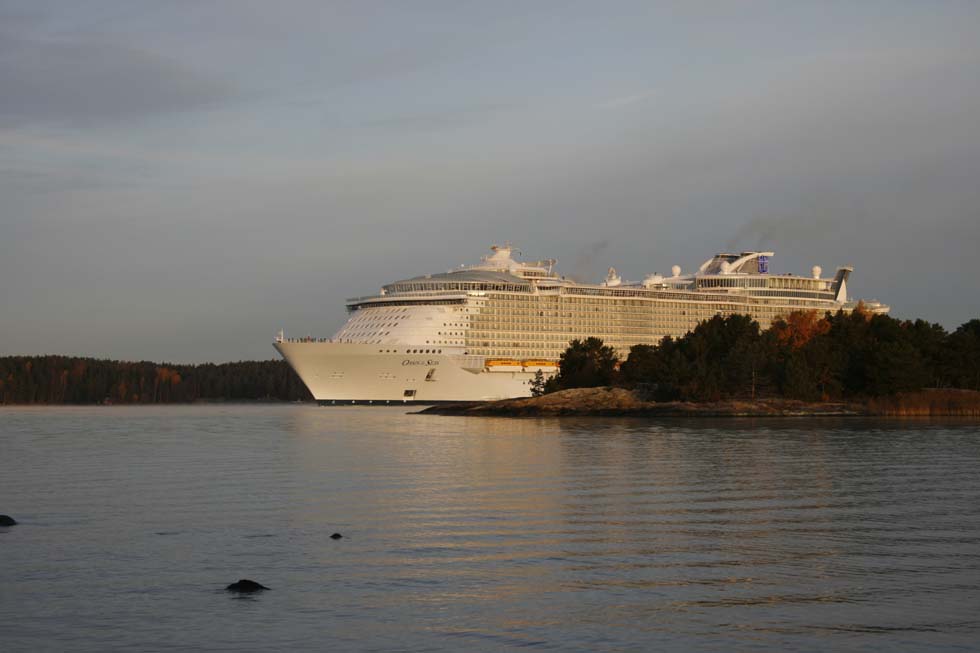
“Oasis of the Seas” of Royal Caribbean, leaving STX shipyard at Turku, 30 Oct.2009 (Zache, via Wikimedia)
Shipyards
After once-famous shipyards of Great Britain, Germany and the United States had ceased passenger-shipbuilding, around 90% of new cruise ships (in terms of capacity) were built by the “Big Four”: The traditional shipyard at Saint-Nazaire in France, the newer ones in Finland, the Fincantieri shipyards of Italy and the Meyer Werft of Germany. Generally construction has been accelerated by assembling sections and completing the ships in drydocks.
The famous enterprise in Finland was OY Wartsila, renowned for building the first ferries with cruise ship comfort. After insolvency in 1989 it was saved by shipping firms as Masa Yards, in 1991 taken over by the Kvaerner group of Norway, labeled Kvaerner Masa Yards until amalgamation with Finnyards in 2004 as Aker Yards. In 2006 Aker and Alstom agreed on merging Finnyards and Chantiers de l’ Atlantique of Saint-Nazaire. Then surprising news were published: “In 2007 Aker ASA asked first Samsung and Daewoo to ‘buy’ Aker Yards (…) Samsung refused because they announced to have own cruise business plans starting from 2010 (…). So, STX was the winner” (HANSA Intl. Maritime Journal, Oct. 2008). The Korean STX Group had risen its share in Aker Yards ASA to 89% and the company was renamed STX Europe.
Chantiers de l’ Atlantique of Saint-Nazaire is world-famous for having built liners such as the “Normandie” and “France”. Then the shipyard was taken over by GEC Alsthom, saved by the government-supported Alstom Group, later becoming Aker Yards France, taken over by STX, diversified from STX Finland, becoming STX France, one third of the shares remaining in the hands of the French government.
The Fincantieri Group of Italy is number two in capacity. It’s the result of regrouping several Italian shipyards under state control into one company.
The family-owned Meyer Werft at Papenburg in Germany is connected with the North Sea by a difficult access through the river Ems. Some environmentalist initiative had tried to prevent an improvement, seeing frogs endangered. Fortunately enough Gerhard Schroeder, at that time Prime Minister of Niedersachsen, found the solution by declaring the work a “military” measure. Together with the supply industry providing jobs for more than 50,000 people, the shipyard is of fundamental importance for Germany as a shipbuilding nation. Former STX was entered and Meyer Turku appeared.
With the Diamond class of Princess Cruises, also Mitsubishi H.I. of Japan had proven its ability to build perfect cruise ships, nonetheless the next megaships were commissioned in Europe again. In 2011 however, for AIDA of the Carnival Group new cruise ships were ordered in Japan. Some passenger whispered that the 125,000-ton ships could not have been built in Germany, being too big for the river Ems, but the 144,000-ton “Norwegian Breakaway” made that passage, to be followed by still larger ships. In 2012 the intention of building cruise ships also in China was reported.
Before STX Europe appeared, the German newspaper Handelsblatt had written in 2001 (16 May): “Some insiders say that the dreamship builder (Meyer Werft) of the North German province is worldwide the only one in that crisis-prone industry which works profitably (…)”. Years before, according to Handelsblatt, the EU had admitted subsidies for building cruise ships with 7% of their value. Building the “Sovereign of the Seas” by Chantiers de l’ Atlantique had been subsidized with c. 500 million franc (according to La Vie du Rail 1989). It was justified by the practice of financing newbuilds mainly by the shipyards. And the high exchange rate of the euro has become a problem to be solved.
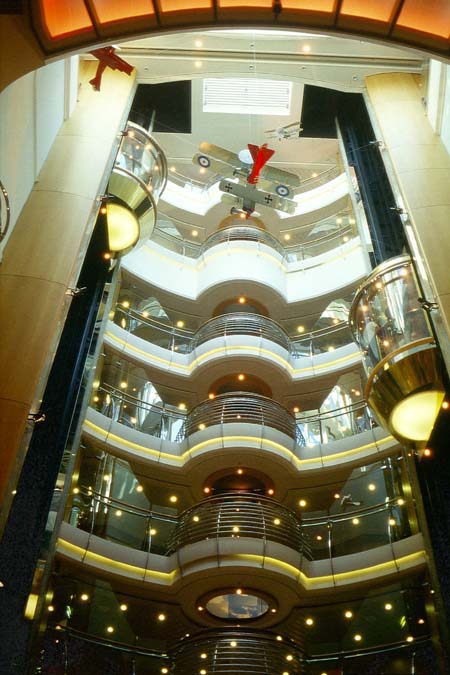
“Mariner of the Seas”, the forward Atrium (WS)
|
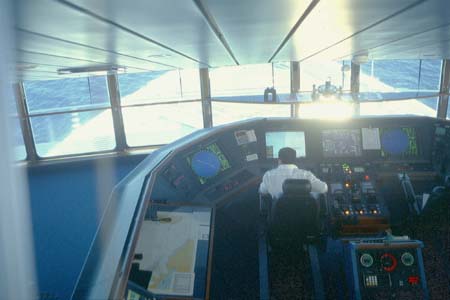
“Mariner of the Seas”, the Navigation Control Station
|
The Environmental Issue
The ‘Blue Riband’ winner “Mauretania” had burned at full speed 850 tons of coal every 24 hours. Concerning modern cruising megaships, Royal Caribbean published e.g. for the much larger “Mariner of the Seas” a fuel consumption of 10,637 kg or 11,436 litres per hour when running at full speed of 22.5 knots. With 5,078 persons (passengers and crew) aboard, it means c. 5.40 litres per person per 100km. That is roughly the equivalent of the consumption per person traveling by motorcar (with driver and one passenger) or the passenger rate on a long-haul flight. As cruise ships don’t run continuously at full speed, consumption per diem is much lower. Nevertheless in 2011 the German Naturschutzbund (Nabu) criticized that shipping generally does not use clean diesel, but cheaper fuel. A solution is a change to cleaner diesel fuel. Obviously Nabu didn’t know that shipping’s share in greenhouse gas emissions is less than 2% (if industry and agriculture is not “forgotten”) and passenger transport, ferries included, is representing only 8% of shipping activities (according to Focus). The market share of cruising is estimated only c.0.5% within all the shipping activities. With new and larger ships, fuel consumption per passenger will be reduced further, a necessity in consideration of a long-term rise in fuel prices. For the “Celebrity Eclipse”, built by Meyer Werft, the press (Welt am Sonntag) reported an energy consumption 30% lower compared to ships of equal size, last not least on account of a sophisticated hull design. Some media praised “biofuel”, made of corn, being a fuel for future. But in a world where a billion of people are on the brink of starvation, it would be the most disgusting atrocity to let them starve in order to produce fuel instead of grain. As a more realistic solution was praised (e.g. by Der Spiegel, 12 August 2013) the usage of liquid natural gas, but for passenger shipping the danger of a fire catastrophe could be a serious obstacle.
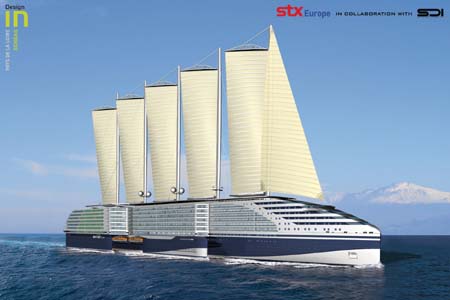
“Eoseas” study (STX Europe)
|
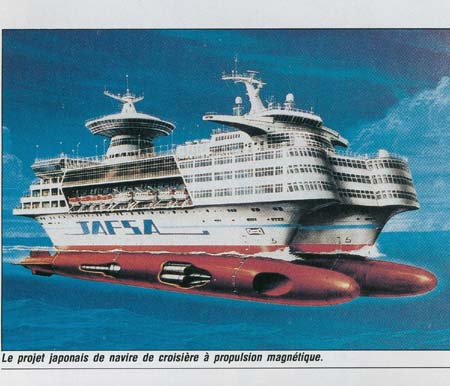
A Japanese study (JAFSA)
|
Among the hypothetical futuristic studies, the researches by STX France under special participation of Sterling Design, published under the title “Eoseas”, are of a revolutionary concept: The design shows a large wind-assisted propulsion vessel, laid out as a five-mast schooner with computer-controlled sails, energy and air emission management, waterjet propulsion, the structure resembling a multi-hull type, with an innovative bow, following new experiences. The hull design is based on the air cavity principle, which pushes air bubbles under the bottom to reduce friction. Nevertheless the study is showing passenger amenities comparable to the “Oasis of the Seas”, including the ‘Central Park’. For the experience with wind-assisted propulsion, the Windstar Club Med type vessels may be compared, see the chapter Cruising Clippers. STX Europe is publishing on its Web site also other strikingly innovative design ideas without sails.
Researches in new technologies are continuing. A completely futuristic design study by JAFSA of Japan had been published in the late 80s. It shows a twin-hull cruise ship without any conventional bow and with a hypothetical anticipation described as “electromagnetic” propulsion. At present however, the well-known nuclear-powered U.S. aircraft carriers are monohulls of a more conventional design and so it could be estimated that also the next generation of cruise ships will not abandon tradition completely.
A development which has become standard is the advanced water purification system. Innovative megaships are releasing only fully purified drain water into the sea. All other waste material is landed in ports. Propaganda against the cruise ships’ passage e.g. through the Canale della Giudecca of Venice possibly is based on a lack of information. Arctic and Antarctic regions however should be protected from mass tourism. An astonishing matter is the international rule demanding to throw away all the food which had been presented on an open buffet. The words of Pope Francis (Franciscus) can’t get of our mind: “Throwing away food is like stealing from the table of the poor and the hungry.”
Cost
In the first years of the 21st century the Carnival Corporation with its more than 50,000 employees achieved a net profit of more than one billion dollar per annum (according to Kurt Ulrich: Zeit fuer Kreuzfahrten, edited in 2005). Some small European companies however had to struggle through life. Old ships changed ownership and name more than half a dozen times. An experienced shipping consultant confirmed that with cruise shipping, dependent on the tourism industry, the yield is much more difficult to obtain than with bulk carriers or container ships. For cruises from American ports of departure aboard the megaships of the biggest companies, minimum rates per diem of c. 70 to 100 dollar were reported in 2007, before the economic slowdown created uncertainties. Those rates have become possible by working with a passenger/crew ratio of 2.6 to 1 on typical megaships, compared to c. 1.5 to 1 on “ultraluxury” vessels. Compared to the minimum fare of a mainstream cruise, the lowest rate aboard an ‘all-outside-cabin ultraluxury’ ship can be expected five times higher (and still only half the rate per diem compared to the few famous nostalgic special trains).
Cruises within the means of the working-class would not have been possible under European or US working conditions. Years ago French officials confirmed that the sale of the “France” was caused by this problem. In order to minimize operation cost, most companies have outflagged their ships for registration with countries of low labour cost and taxes, such as Panama, the Bahamas or in the past even Liberia. By this way cruise shipping (and to a much larger extend cargo shipping) created jobs for many people of the Third World. Generally an employee on a cruise ship gets after 6 months continuous work 2 months vacation and the return flight to his home country, may it be in Europe, Asia or elsewhere, is paid by the company. The crew members (1,360 e.g. on the “Freedom of the Seas”), are accommodated in 2-berth cabins, strictly separated from the passengers’ areas. Megaships generally stay in their homeport just for half a day, a further way of reducing costs.
Outflagging must not mean a reduction in safety standard, which worldwide has to fulfill the requirements of international rules. “Cruise ships want to be associated with a quality register and we have the largest concentration of cruise ships in the world”, stated the Bahamas Maritime Authority director John M. Jones, quoted by Newsweek (22 April 2002). Though registered elsewhere, the cruise ship fleet is mainly in American hands. Outflagging is not the only way to raise profits: Due to estimates at least a quarter of the big operators’ yield is coming from additional on-board services provided.
The success of cruising is connected to the travel industry and agencies worldwide. Online booking, less circuitous, has become an alternative. Big tour operators reserve allotments on certain ships for individual journeys or for package tours. In Europe, package tours initially had been offered in connection with trains, e.g. sleeping-car specials or the TUI expresses. Now passengers everywhere arrive by plane or after a stressing bus ride at the port of departure, but Royal Caribbean included already high-speed train rides into package tours.
Dangers
The dangers of seafaring, fire on board, reefs or hurricane, have been always existent – and not every accident can be mentioned with the main chapter Cruises. After in 1996 the “Hanseatic” had an accident in the Northwest Passage, a well-known German news magazine, knowing what readers wanted, mocked: “When on 29 August the ship grounded on a reef closely under the surface in Arctic waters of the Northwest Passage, the rich and the old passengers celebrated the event as a welcome change from the monotony of cruising with drinks.” The accidents reported concerned small ships taking exotic routes. On Friday, 13 January 2012 at 21:45 during festive dinner time, the “Costa Concordia”, a modern mega-ship of 114,500gt, rammed a rock in the strait between the peninsula Monte Argentario of the Italian Toscana and the island of Giglio. She grounded and the courageous rescue team could not save everybody among the 4,229 people from the half-capsized ship. Captain Francesco Schettino stated that the rock was not recorded by the nautical charts. Media asked why the ship did not take the open sea route in order to avoid the dangerous passage, but such a demand would exclude cruise ships from calling at the most picturesque islands of the Mediterranean, the Caribbean and the Indian Ocean, such as Santorini, St. Thomas or the Seychelles, not to speak of Norwegian fjords or the Strait of Magellan. From the beginning of cruise shipping, its purpose was not crossing the oceans on the fastest way. After the accident, Chairman Pier Luigi Foschi expressed his regret by a letter sent to all the Costa clients, thanked the crew and the rescue team for having saved more than 4,000 people and assured the public of keeping a close check on the Safety Management System. Despite the few accidents which ever happened, cruising is the safest way of travelling.
Permanent dangers are hurricanes and tsunamis with their waves, causing alteration of routes and timetables. Still more malicious are the mysterious ‘freak waves’. The “Queen Elizabeth 2”, built to stand rough seas, was hit by such a wave of about 30 metres, the reason why the lifeboats of the QM2, built for the North Atlantic, are placed 30m above sea level, well protected. Also the “Norwegian Dawn”, a conventional 91,000-ton cruise ship, withstood such a ‘freak wave’ (as mentioned by Arnold Kludas). Smaller cruise ships survived such an attack, too, but how many freighters disappeared for ever? For a long time traditional science has denied the possibility of those waves. Now, with the help of satellites, it was proven that they may appear on all oceans, at any time – and it must influence safety regulations, early warning systems and ships’ design. Already after the “Titanic” catastrophe, obligatory SOLAS regulations had changed design. In 1948 the International Maritime Organization (IMO) was founded, and existing safety measures were to be ameliorated worldwide. Fire was always among the most frightening dangers. For the last classic oldtimers, the new SOLAS 2010 regulations, banning many combustible materials, meant the end of their career (in the chapters to follow, all these ships affected cannot be enumerated). And progress continued.
A danger is infection of passengers by contagious disease. Infected passengers have to be enclosed in their cabin. Without doubt it’s better to load food at Miami, Southampton or Okinawa instead of exotic tropical ports.
Apart from the everlasting dangers of seafaring, additional threats have arisen. When terrorists captured the “Achille Lauro” in 1985, Mediterranean cruising suffered a severe setback. In 2005 Turkish security forces prevented terrorist attacks on cruise ships operating for Israel. Generally the mainstream cruises are avoiding ports of countries considered as being endangered by political troubles, e.g. the utmost south-east of the Mediterranean. “Many cruise lines have also responded to September 11 by redeploying ships closer to home”, reported Newsweek in 2002. After September 11, cruise ships in the USA went to Maritime Security Level III, then downscaled to level I. Maintaining a security zone around the cruise ships, screening bags and employing secret onboard security forces became standard. Problematic are neighboring cargo ports.
Piracy
Another danger was registered by the media when in 2005 armed pirates fired on the “Seabourn Spirit” close to the Horn of Africa. ?nly with skilful manoeuvres the Captain could save ship and passengers. In April 2008 the French cruise yacht “Le Ponant” was captured by pirates. Days after, French helicopters caught the pirates in the Somali desert and brought back the ransom. Piracy escalated around the coast of conflict-ridden Somalia and warlords participated in the booty, thus financing the international arms trade. In late 2008 NATO countries with the EU mission Atalanta and also Russia, China and other nations announced coordinated naval operations in the seas between Kenya and the Horn of Africa. Carried out with too few ships, it was disappointing. Nevertheless the German frigate “Mecklenburg-Vorpommern” saved the cruise ship “Astor” in November 2008 from being captured. In the same month the “Nautica” ex “R Five” escaped from an attack. In March 2009 the German frigate “Rheinland-Pfalz” delivered captured pirates to Kenyan authorities, but from then on the ship was kept for more than a month at Mombasa, for the officers had to testify against the pirates. In the meantime piracy celebrated its triumph: In the first three months of 2009 they attacked 62 merchant ships (according to press reports), tenfold the number of attacks in the first quarter of 2008. On occasions, pirates killed crew members, generally people of third-world countries. The ransom for every freighter and its (white) officers, up to 3 million dollars in cash, coming from London or elsewhere, was dropped by parachute. The millions were transferred out of Somalia to Dubai (according to a CNN report). Sensation created the attack on the Italian cruise ship “MSC Melody” in April 2009, 200 miles north of the Seychelles: “They tried to put up a ladder with hooks. They were climbing up, so we reacted. We started firing. When they saw us firing (…) they gave up and went off”, said Commander Ciro Pinto (quoted from the Daily Telegraph, April 27, 2009). The security forces on board were Israeli professionals. After the attack, the Spanish supply ship “Marques de Ensenada” escorted the “MSC Melody” to the Red Sea. For the next four cruise ships expected in the area a navy escort was announced. The head of the East African Seafarers’ Assistance Programme in Kenya criticized the “Melody” for carrying handguns – but without, she ship and the 1,500 passengers and crew would have been captured and the ransom for survival could have been hundreds of million dollars. In some case, the ransom was whispered having been carried by courageous messengers on a tug boat from Mombasa in Kenya to the Somali coast. The number of only c.20 warships (according to Wikipedia, the other naval vessels being supply ships) at that time employed in an area of more than 2.5 million square kilometers proved insufficient. Admirers of piracy even invented the lie that the freighters crossing the Indian Ocean generally are armament transporters. Years ago also the busy Strait of Malacca, endangered by armed pirate boats, was classified by Lloyd’s as a war zone. Piracy did spread to the coasts of Ghana, Benin became endangered and concerns arose that piracy is moving further.
Service and Comfort
The ships’ service quality is rated by Douglas Ward’s “Berlitz Complete Guide to Cruising & Cruise Ships” for modern megaships generally with around 4 stars, Celebrity even 4 plus, for the tiny “ultraluxury” category with 5 and for many old small, midsize and aged megaships around 3. Nevertheless, a travel aboard an old ship can be a wonderful experience and passengers like these ships. An idea of the space aboard is given by the so-called passenger/space ratio, the gross tonnage divided by the number of passengers. The “Queen Elizabeth 2” achieved a ratio of c.40, the “Queen Mary 2” c.57, the “Oasis of the Seas” c.41, the “Norwegian Epic” c.37 and the “Quantum of the Seas” c.38. That means rationalization. The top-end is represented by the “ultraluxury” vessels, e.g. the “Silver Shadow” of Silversea Cruises with a passenger/space ratio of c.74. Compare it to the ratio of c.19, which was the standard of the “Titanic”, though she had been one of the most comfortable ships of this time.
Nowadays the comfort of modern megaships is incomparably better than on the ocean liners of the bygone epoch. Gone have the days of 2-berth cabins with berths set one above the other, not equipped with a private bathroom. Now every cabin has an own bathroom with toilet and shower, a comfort confined in the past to a few 1st-class suites. Even in outside cabins of the lower categories, big windows make forget the minuscule portholes of the old liners. A great number of staterooms is placed high above the lifeboat deck, while dining-rooms and theatres moved downstairs. On most cruise ships the class separation has gone and all passengers are welcome to participate in the Captain’s Cocktail Party.
With “Freestyle Cruising”, NCL introduced a free choice of seating for dining and abandoned formal dinners. Some Europeans did already misunderstand it as “typically American”, though the typical American brands continued to provide conservative service. Aboard AIDA ships, only self-service buffets were offered being “inclusive” and casual dressing is standard. Buffet service must not mean a cost reduction, for generally dishes presented at the buffet are not permitted to be returned to the galley. Competitors are offering a free choice among various restaurants, buffet or full-service, but they are maintaining formal dinners with fixed seating in the main dining-rooms, too, thus avoiding any struggle for seats. And people continue to dress up for festive events, they like it. In the formal dining-rooms even on so-called mainstream cruises the guests enjoy four-to-five-course a la carte menus, comparable to the First Class of the best ocean liners, while in the19th century on less famous steamers one fixed table d’hote had been offered. Also additional restaurants for guests eager to pay a supplement were introduced, a service offered already on board famous liners of the past. On nowadays’ mainstream cruises a high level of cuisine is standard. Some magazine complained of the menus, obviously not knowing that they are more and more inspired by Michelin star chefs. Nevertheless the solitary nagger has survived over the centuries, though perhaps he is not among the passengers.
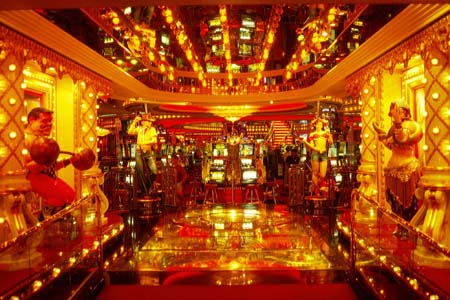
|
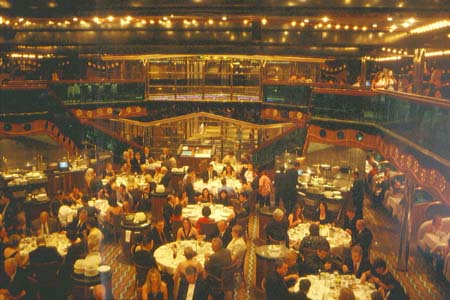
|
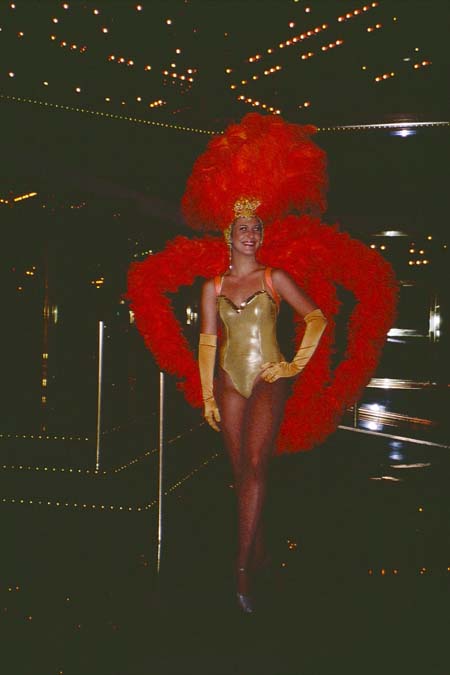
“Mariner of the Seas” Casino, “Carnival Triumph” and “Oasis of the Seas”, the Boardwalk (WS, Royal Caribbean)
|
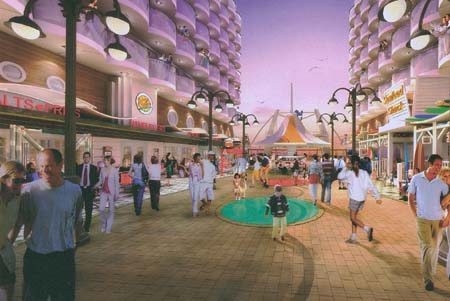
|
Amenities
The press eagerly took notice of amenities and entertainment offered on new ships such as theatres, spa centers and gyms, bowling, swimming pools, mini-golf, ice-skating, rock-climbing… “Entertainment is a big part of the cruise experience on almost all ships, but especially on the megaships”, wrote Frommer’s, continuing: “Usually twice in any weeklong cruise, there’s apt to be Vegas-style musical revues performed early and late in the main show lounge, with a flamboyant troupe of anywhere… Ships carrying 100 to 400 passengers have fewer entertainment options…” Staging a top show was estimated (by Berlitz Guide 2010) at 0.5 to 1 million dollar. And also for the shopping facilities on board a sufficient number of customers is necessary, requiring megaships of a certain size.
With the Sovereign class of Royal Caribbean, a multi-storey lobby and with the Voyager class the ‘Royal Promenade’ mall was introduced, revolutionizing ships’ architecture and banning claustrophobia. It was modeled after the Finnish car ferry “Silja Serenade”, a design by Kai Levander and Harri Kulovaara, who became Royal Caribbean’s Chief Naval Architect.
With Royal Caribbean’s Oasis class and its sunlit Central Park, lined with balcony cabins raising 6 decks high and leading into an amphitheatre-styled Aqua Theater above the stern, Jules Verne’s dream of a city or an island afloat seemed to come true. Is any further development imaginable without exaggerating the ships’ size? The author’s (an architect’s) idea is a central promenade ascending from stern towards the upper deck and the bridge, thus connecting more than half a dozen decks (the commercial center at Kyoto railway station, designed by Hara Hiroshi, might be a vague example). A palm-tree garden could crown it, during winter cruises covered by a removable glass roof. The green vegetation on upper deck would be a reminder of the “Alexandria”, designed by mathematician Archimedes, reportedly with a garden on deck, when she sailed in 219 B.C. from Syracuse to Egypt. The decks in front could be piled up like an antique Mediterranean island city – Hermoupolis on Syros could be an example.
Raising the number of outside cabins and equipping them with balconies have been during the last decades among the most important features of new cruise ships. Knut U. Kloster’s unfulfilled dream of a 250,000gt “Phoenix World City” showed this guiding principle. Surprisingly, the innovative cabin arrangement of the old “Canberra” with some outside view for inside cabins obviously was never copied. There are improved wellness facilities and also children’s playgrounds on board. A great advantage of modern cruise ships is the wheelchair access. Every big cruise ship has at least one doctor on board, digitally linked with medical centers ashore. And last but not least, the chapel, suitable for every confession and used also as a wedding-chapel, was not forgotten.
Some critics simply dislike the megaships’ size, disregarding the sea-sickness aboard small vessels when pitching through heavy seas. And they may consider some amenities being attractive only for media reports – not listed with the chapters to follow. Most important for sleeping is a quiet cabin, a problem aboard aged vessels. A German TV program argued that passengers of the megaships ‘cannot see the sea’. But obviously they can, otherwise the majority of world’s cruise passengers would not choose these giants – “incredible new super-liners which are glamorous, glittering, movable cities”, an impression given by Jeraldine Saunders, author of the successful book and TV series “The Love Boat”, which contributed so much to modern cruise shipping’s success, expressing what so many cruise enthusiasts feel: “…Traveling at sea really is theatrical”.
Style
Nostalgia was the typical feature of prestigious liners at the end of the 19th and the beginning of the 20th century, described by the Swiss author Kurt Ulrich: “The “Imperator” of 1913 had a Pompeian spa… on the “Champollion” of 1925 the lobby, restaurant and 1st class music saloon represented almost an Egyptian temple”. Then a completely new style emerged, sumptuous, but not nostalgic – the “Art Deco”. It became epitomized by the “Normandie”. That dazzle, somewhat surprising in an era of the cool modern architects Frank Lloyd Wright, Le Corbusier, Perret, Gropius and Mies van der Rohe, ended at latest with WWII.
Already a decade after World War I the German liners “Bremen” and “Europa” initiated a revolutionary break from sumptuous appointments and plush comfort of the Victorian, Edwardian and Imperial epochs. The architects Fritz August Breuhaus and Paul Troost stood for much light and clearness in combination with a sober and practical comfort for all classes. The new style appeared as ‘Dampferstil’, Ocean liner style and ‘style paquebot’. After the Second World War, this way of styling has been perfected with the “United States”, the interiors being styled by Dorothy Marckwald. The last Italian ocean liners followed that style, with an additional ‘Mediterranean’ touch. And also the original interiors of the “Queen Elizabeth 2” were styled in a sober modern way by Michael Inchbald.
Ulrich continued: “When in the ‘70s of the 20th century the first true new cruise ships departed, the decent Scandinavian style was dominant. Nowadays the interiors are characterized by specialized interior design offices: Partner Ship Design of Hamburg, Katzourakis of Athens, Studio de Jori of Genoa, Tillberg Design of Viken, Sweden, Joseph Farcus of Miami”. In the South Beach district of Miami, Art Deco had been rediscovered and from the port of that city Carnival’s Farcus-styled ‘Fun Ships’ are departing. Most competitors relied on a more moderate styling. And in future? Will young academics be impressed by the avant-garde movement of the 1920s which “… people are now clamoring to rediscover”, as Newsweek wrote? Will the eccentricity of the early 20th century with Pompeian spas and Egyptian temples have a revival? Or will the sober ‘Ocean Liner Style’ be reborn? The interiors of the AIDA and Celebrity ships built by the Meyer Werft are showing a modern elegance. Anyway, arrangement of all the facilities required and the dream world desired in a spirit and configuration much more open than on the classic ocean liners of the past represents the true progress in design of cruise ships. Could it once resemble the attempts in creating a completely “liberated” architecture, anticipated in the 1920s already by Israeli architect Frederic Kiessler, approached by Frank Lloyd Wright with the Guggenheim Museum and targeted by nowadays’ star architects?
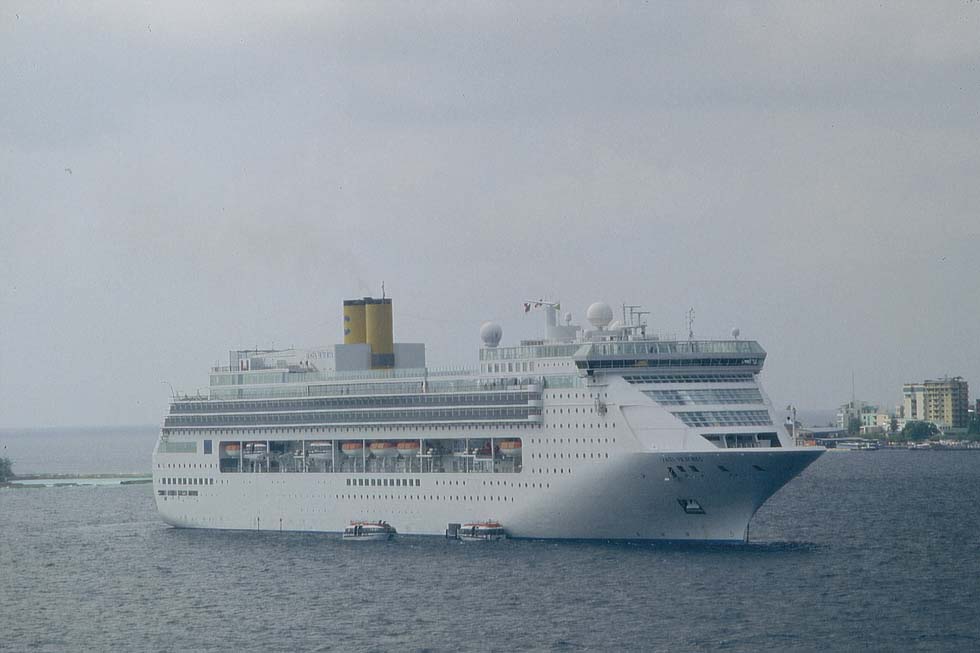
“Costa Victoria”, Male, Maldives 2012 (WS)
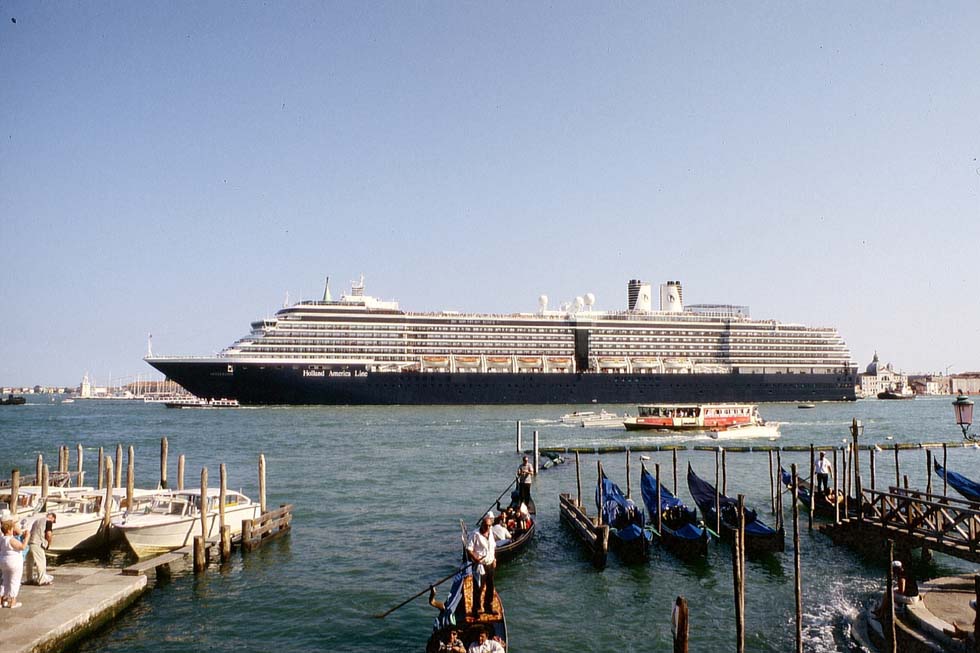
“Oosterdam” of Holland America, Venice 2009 (WS)
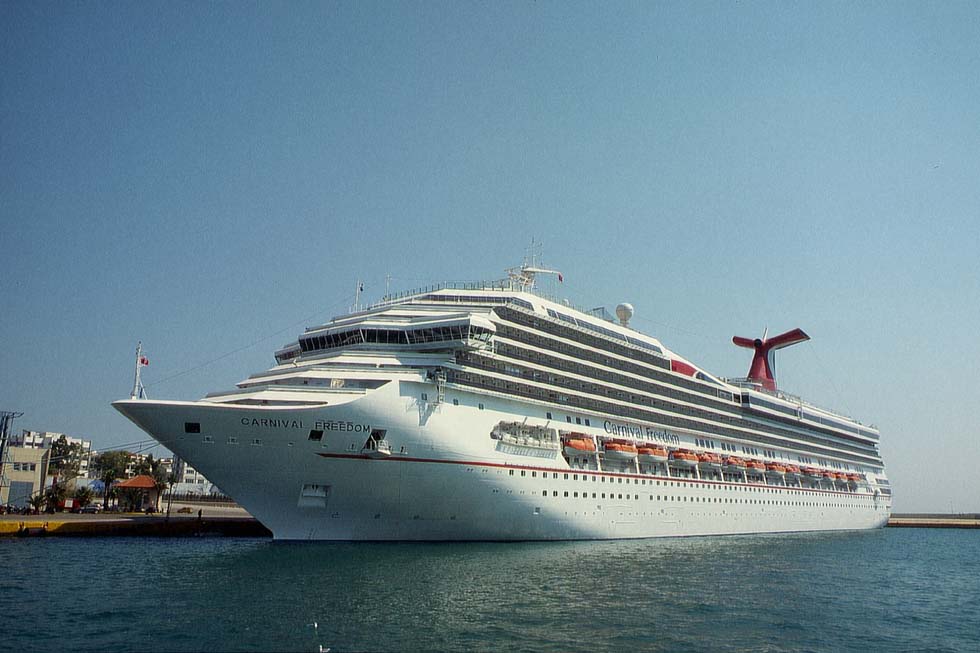
“Carnival Freedom”, Conquest class, Piraeus 2008 (WS)
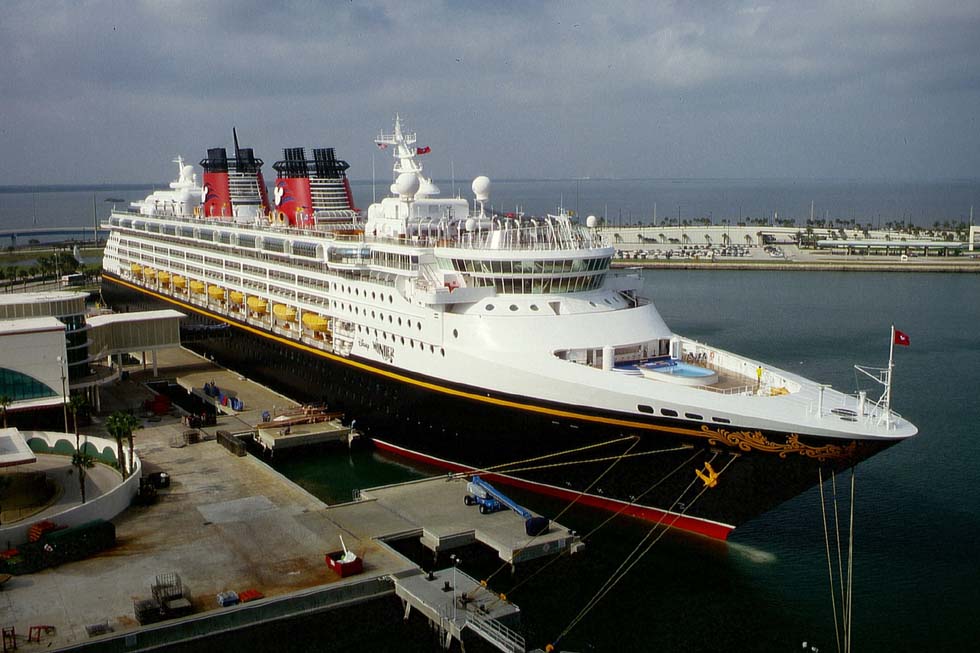
“Disney Wonder”, Port Canaveral 2008 (WS)
Appearance
A century ago the classic ocean liner was symbolized by the four-funnel steamers of Norddeutscher Lloyd, by the “Titanic”, “Vaterland” and the legendary “Mauretania”. Between the wars a new shipbuilders’ architecture emerged with the “Bremen” and “Europa”, an innovative design by Dr. W. Suechting, the “Rex”, the “Normandie”, an outstanding design idea of Vladimir Yourkevitch, the more classic “Queen Mary” (I) and “Queen Elizabeth” (I), then the new Italian liners by Dr. Nicolo Constanzi, the “United States” by William Francis Gibbs, the “Queen Elizabeth 2” by John Starks and last but not least the “France”, the beautiful latecomer and winner in length and aesthetics.
Cruise ships have a different task and necessarily they differ in aesthetics. Placing engines and funnel aft instead of midships is a principle modeled on the “Southern Cross” of 1955. Old cruise ships are nice, but as space is more important than speed, the sleek hull has given way to a more rectangular shape, towered by a huge superstructure, criticized by maritime historian Reuben Goossens (ssmaritime.com) as the “floating apartment (condo) boxes of today”. Nevertheless, wherever one of those vessels dropped anchor and has disembarked its lovely load of tourists for their sightseeing tour, the floating giant is being left behind as an eyecatcher. Whether it will be admired as a technical wonder or a piece of exaggeration depends on the point of view and the personal attitude. The one may praise its speedy clipper bow, the flowing bridge front, the extravagant viewing-lounges and the abstract creation of a funnel as an expression of modern elegance, the other, more conservative enthusiast bears still in mind the timeless elegance of the old classics. And he may remember the words of Raymond Loewy, who had introduced a new style in the 1930’s with the ferry “Princess Anne”: “Fully on the track of the “Princess Anne” look, naval architects in America and overseas got about to design vessels creating the impression of floating monsters (…). Sometimes I asked myself, whether I should have designed the “Princess Anne” at all. Haven’t I encouraged that massive stylebreak by myself?“ The little U.S. West Coast ferry “Kalakala” was still more exaggerated and in 1941 an advertisement of Matson Lines showed a fancy drawing of a white ocean liner with two funnels packed into a yellow streamlined structure. Later Costa, Holland America and Celebrity with the advanced Solstice class turned away from the “Princess Anne” look. Other companies refined it, creating funnels of a racy elegance. Generally, the funnel with its paint scheme is a distinguishing mark of the shipping company. Hull and superstructure of most cruise ships are painted white, a few conservative companies kept on the tradition of a black hull and some “informal” brands tried colourful dazzle paints.
Already in the 1920s Le Corbusier, the great architect, admired the functionality and size of big ships: “Daring and with wisdom the designers of the ocean steamers are creating palaces which make the cathedrals looking small, and they throw them into the sea”. Maybe he would have praised nowadays’ megaships, too. Decades ago, the attempts by Italian designers in developing an architecture of its own for cruise ships were published by the trade press. Nowadays the aesthetic quality of certain new ships, built in Italy or elsewhere, is recognized by experts and maritime enthusiasts as well, though not every ship is appreciated. The beauty of the “QE2” remains undisputed. With the “Queen Mary 2”, designed by Stephen Payne, the Chief Naval Architect of the Carnival Corporation, a post-Panamax vessel of that pretension was realized. She represents the beauty of a modern North Atlantic Liner. A post-modern interpretation of the classic ocean liners’ appearance with two funnels (one being a dummy) became realized with the “Disney Magic” and “Disney Wonder”, though they are pure cruise ships.
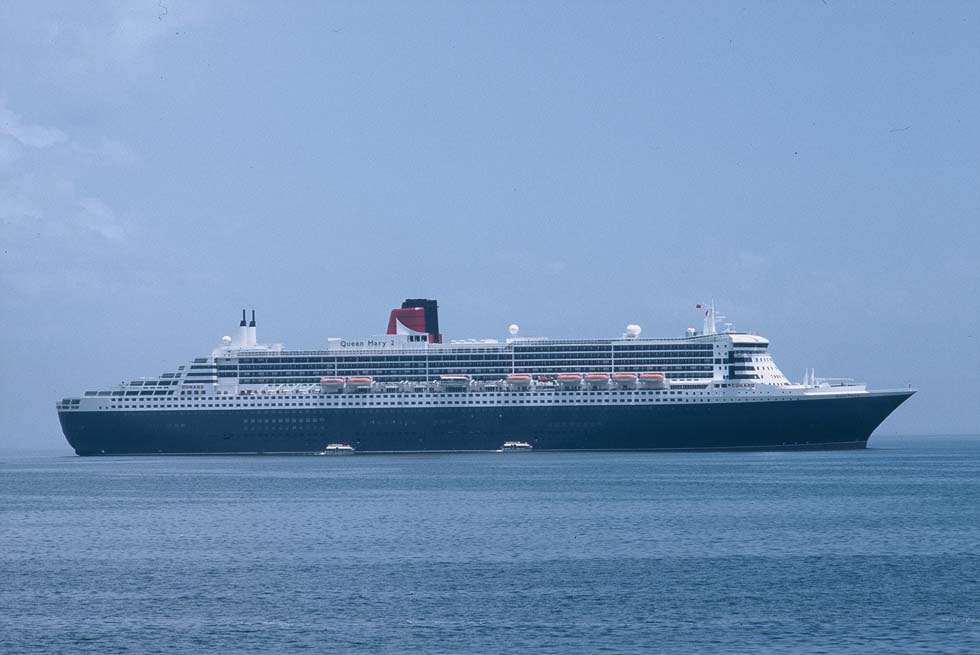
“Queen Mary 2” at Panama, 2006 (WS)
Download this picture with 1500 x 1000 pix, 300 dpi

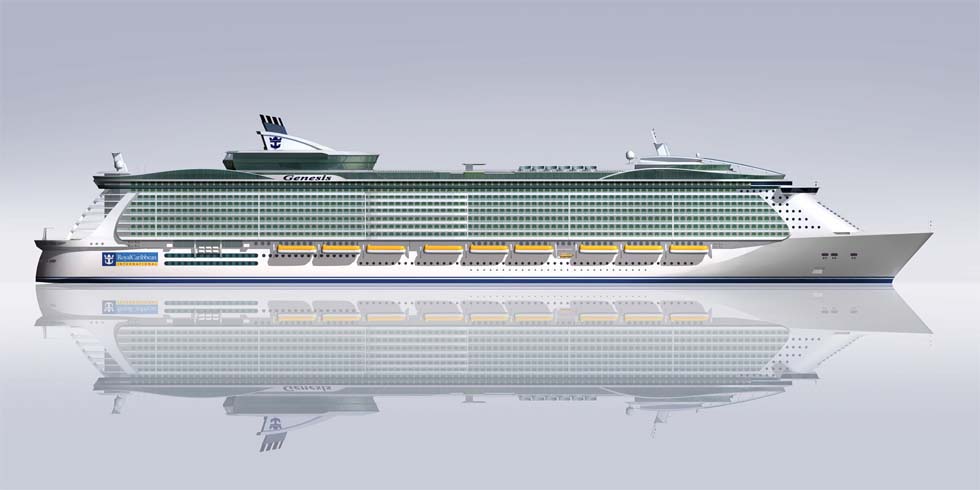
The Genesis project, then “Oasis of the Seas” (STX Europe)
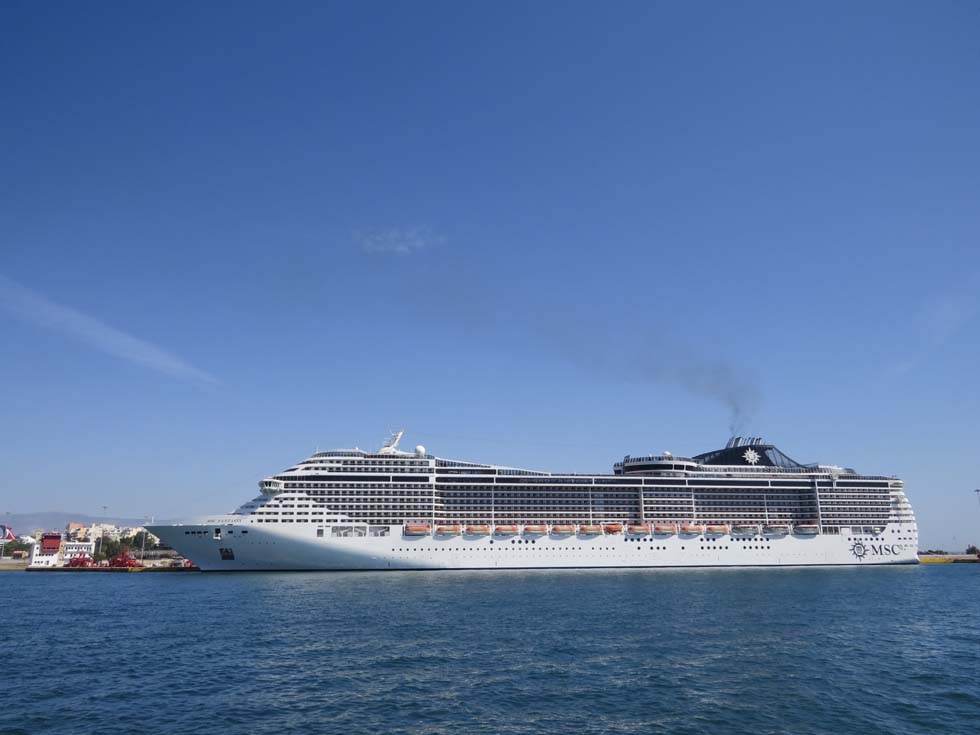
“MSC Fantasia” at Piraeus, 2013 (WS)
Development never stops. With the “Sovereign of the Seas” and the “Legend of the Seas”, Royal Caribbean together with Chantiers de l’Atlantique have contributed substantially to a new architecture. Nowadays the aesthetic quality of certain ships, e.g. the series of Fincantieri, has been acknowledged by experts and maritime enthusiasts as well. With the “Voyager of the Seas”, built at Kvaerner Masa Yards, the later STX, Chief Naval Architect Harri Kulovaara of Royal Caribbean, renowned already for his ferry designs for Silja Line, had opened up new dimensions in size and aesthetics. What will bring future? Has the race for size already reached its peak with the Oasis class? Wartsila published studies of rather uncommon cruise ships (Ships Monthly 1/2012), to be powered by liquid natural gas (LNG). Ship-lovers however remember the sight of LNG-tankers, on account of the tremendous fire hazard being fully illuminated in order to avoid any collision. A new “France” design with the cabin decks located in two “funnels”, anticipated by shipowner Didier Spade for 2015, possibly may not be appreciated by every ship-lover, like some other “futuristic” design studies, too. Future functionality without the funnel of the steam age has already been realized with the newbuilds of the Meyer Werft, beginning with Celebrity’s Solstice class. When such a white giant is passing along the Greek coast towards Cape Sounion with its temple ruin, its sober style may recall the beauty of classic modern architecture – or even of the Parthenon. Could such a structure once be crowned by a superstructure, towering, let’s say, like an antique city atop a hill? In any case, the old Latin saying should be kept in memory: ‘De gustibus non disputandum est’.
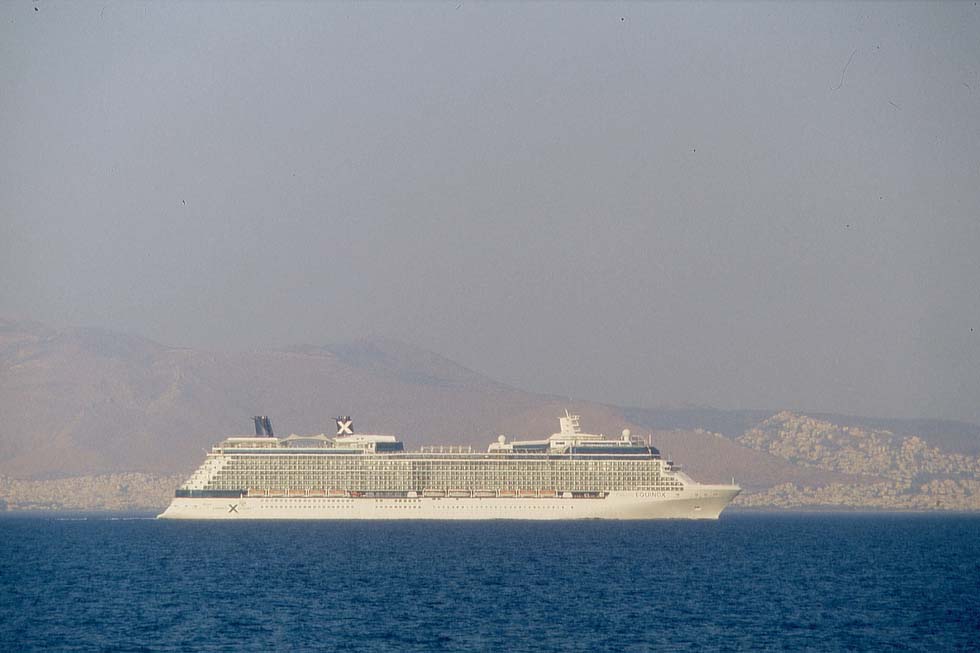
“Celebrity Equinox”, passing the coast of Attica, Greece 2012 (WS)
Download this picture with 1500 x 1000 pix, 300 dpi

Certainly some old sailor will be prone to compare cruising mega ships with skyscrapers afloat. Nevertheless, no matter if beautiful or just huge, when in Miami on a Saturday or Sunday four or more of these giants, after their bass sound has startled the private boats, are passing through the Main Channel, thousands of passengers on the decks and even more people ashore cannot withstand to admire that majestic parade. And when the “Queen Mary 2” calls at a port, daily newspapers had already announced her and people are flocking to the bay, as we experienced it in Piraeus and in Panama. During night hours the illuminated giants are fascinating highlights at their ports-of-call, overtopping the crowd of yachts or ferries, ready to depart past the towns and islands of the Americas, Europe or the Pacific under a nocturnal sky…
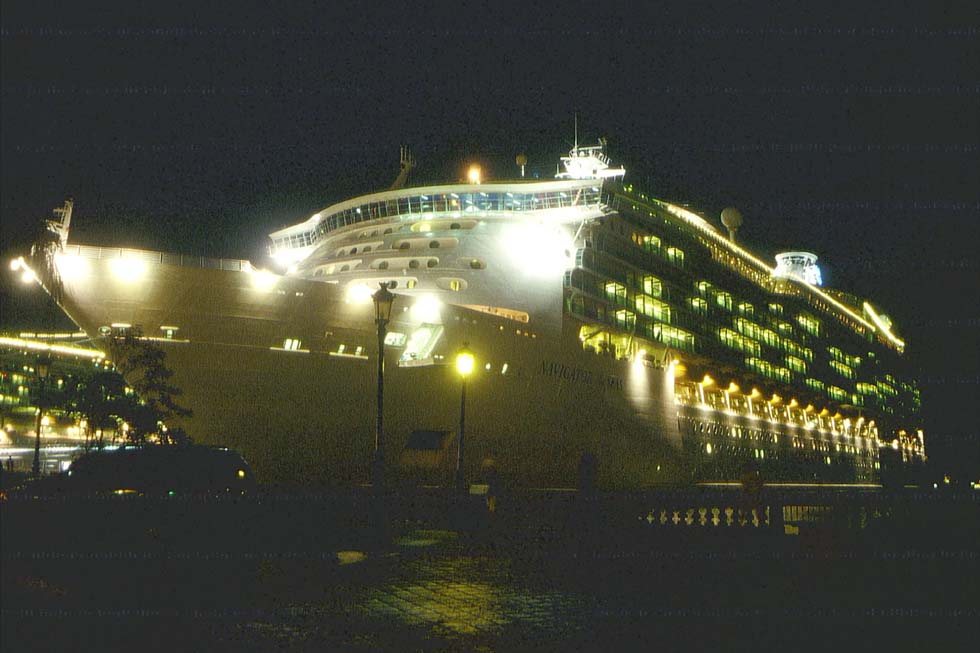
“Navigator of the Seas” at San Juan, Puerto Rico 2007 (WS)
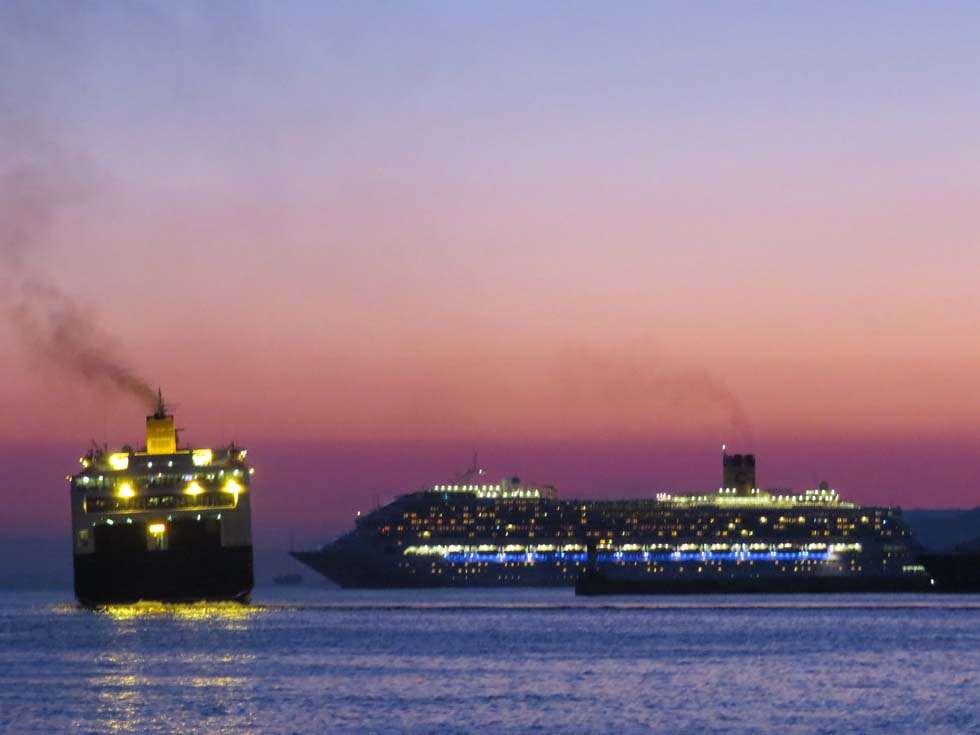
“Costa Pacifica” and a Blue Star ferry departing from Piraeus, 2013 (WS)
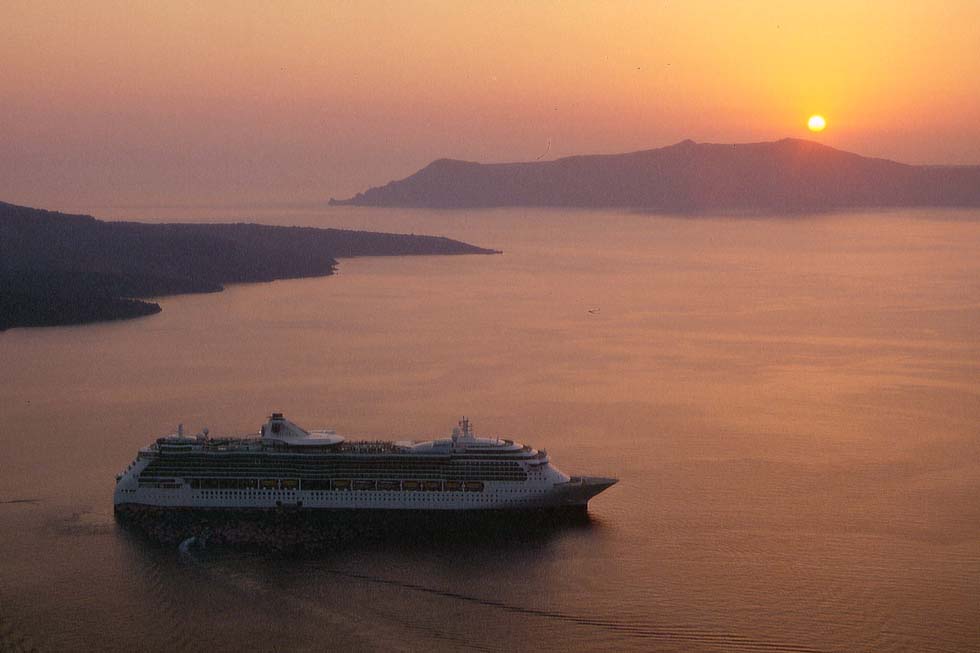
“Brilliance of the Seas” at Santorini, 2007 (WS)
|